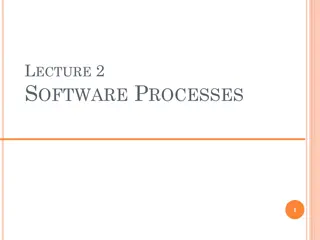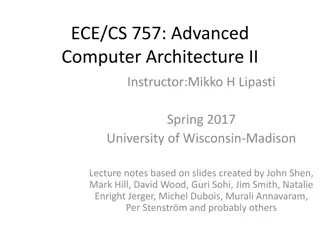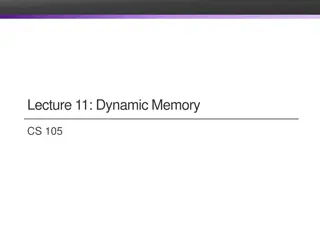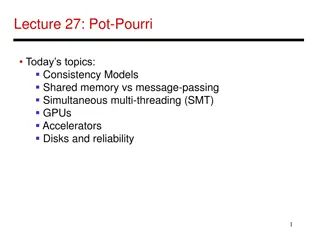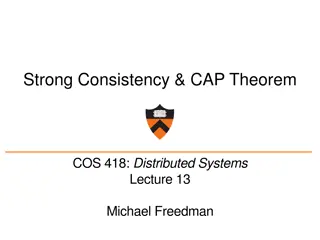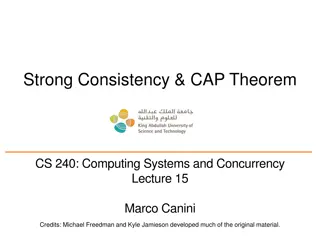Discussions on Programmers' Needs, Memory Models, and Consistency in Software Development
Today's discussions covered various topics including what programmers require, the debate on defining memory models for achieving Sequential Consistency (SC), considerations for data-race-free programs, and the performance trade-offs of weaker memory architectures. Insights into partial and relaxed consistency, mutual exclusion enforcement, and the role of barriers such as fences in maintaining consistency were explored in depth.
Download Presentation

Please find below an Image/Link to download the presentation.
The content on the website is provided AS IS for your information and personal use only. It may not be sold, licensed, or shared on other websites without obtaining consent from the author.If you encounter any issues during the download, it is possible that the publisher has removed the file from their server.
You are allowed to download the files provided on this website for personal or commercial use, subject to the condition that they are used lawfully. All files are the property of their respective owners.
The content on the website is provided AS IS for your information and personal use only. It may not be sold, licensed, or shared on other websites without obtaining consent from the author.
E N D
Presentation Transcript
Relaxed Consistency Finale DAVID DEVECSERY
Administration! Syllabus quiz (last warning!) On Canvas! Review 1 is graded. If you submitted but don t have a grade, let me know If you got a comment, you should adjust future reviews If you didn t get a comment, you had a fine review Sign-up for leading discussions coming soon!
Today: Higher-level discussion What do programmers need? What is unacceptable? What are the costs of providing these abstractions? Some more consistency background and semantics Can we do better than barriers? We Frighten Small Children
Finishing up DRF-0 discussion Advantages Disadvantages
Do you believe the DRF-0 argument? Is it really best to define memory models by what s needed to achieve SC? Is there a better definition? Should all programs really be data-race free? There are legal programs with data-races Do we really need all of the performance that comes from as weak a memory model as possible? What s the performance gain/cost of weaker architectures?
Partial consistency: locking Will this code enforce mutual exclusion on a PC MM? xchg (x, y): atomic { old = x; *x = y; return old } Hint: Think of using the synchronization to lock another variable: Lock: Unlock unlocked = 1 do { } while (tmp != 1) lock() y = 1 unlock () tmp = xchg(unlocked, 0); if (tmp != 1) { while (unlocked != 1) ; }
Relaxed consistency: barriers X86 [X]Fences: All X instructions before the fence will be globally visible to all X instructions following the fence MFENCE (load or store) Handout provided SFENCE (stores only) Handout provided LFENCE (loads only) Handout provided NOTE: x86 also has a LOCK prefix, it is needed and related to fences, but different
Partial consistency: barriers Can we use fences to make this mutually exclusive? xchg (x, y): atomic { } Lock: Unlock MFENCE unlocked = 1 do { } while (tmp != 1) MFENCE tmp = xchg(unlocked, 0); if (tmp != 1) { while (unlocked != 1) ; } old = x; x = y; return old
In what ways can we reorder operations? Data Reordering Read-read Read-write Write-write Memory Atomicity When a store goes to memory, is it visible to all processors?
What reorderings should be allowed here? What are the highest and lowest points line 4 can be reorderd to? Thread 1 1. local1 = 10 2. lock() What are the highest and lowest points line 3 can be reorderd to? 3. shared1 = true 4. local2 = shared2; 5. unlock() 6. local3 = local1 7. local4 = local2 What about line 6? line 7?
Partial consistency: barriers Can we use fences to make this mutually exclusive? Is this an optimal lock implementation? xchg (x, y): atomic { } Lock: Unlock MFENCE unlocked = 1 do { } while (tmp != 1) MFENCE tmp = xchg(unlocked, 0); if (tmp != 1) { while (unlocked != 1) ; } old = x; x = y; return old make it optimal? What constraints do we need (instead of fence) to
Reordering limits Thread 1 1. local1 = 10 2. lock() Acquire semantics Cannot order above 3. shared1 = true 4. local2 = shared2; Release semantics 5. unlock() 6. local3 = local1 7. local4 = local2 Cannot order below
Partial consistency: barriers Can we use fences to make this mutually exclusive? Is this an optimal lock implementation? xchg (x, y): atomic { } Lock: Unlock Store(unlocked, 1, ReleaseSemantics); do { } while (tmp != 1) tmp = xchg(unlocked, 0, AcquireSemantics); if (tmp != 1) { while (unlocked != 1) ; } old = x; x = y; return old make it optimal? What constraints do we need (instead of fence) to
Shifting Gears: Shifting Gears: Silently shifting semicolon Authors argue that for safe languages (e.g. Java), the statement ordering abstraction is essential We shouldn t try to create faster unsafe code, instead we should try to make safe code faster. Different than DRF-0 DRF-0 is fast-by-default, with a burdensome programmer interface They argue for safety-by-default, with unclear performance implications
Should we prioritize safety, or performance? Traditionally work has prioritized performance Is it clear that there is a significant performance cost to prioritizing safety? Existence proof, we program in this environment today, its fine Work prioritizing safety is promising But has gained little traction <30% overhead for SC on some server applications Some languages (e.g. python) enforce SC via uni-core execution
Linux Memory Model: Are you frightened, or just disconcerted? What does a world without DRF0 look like? What does it take to formally reason about all of these weak memory models? This paper explores the significant effort to reason about the linux memory model Case study on the RCU data-structure
What primitives exist? Reason about several primitives Translate into read ( R ) write ( W ), and fence ( F ) operations Specify operations, and data-flow rules in cat language Formal language, allows operations to be
Core model Rules for: Sequential consistency per variable Atomicity of read-modify-write Happens-before Propagates-before (Constrains propagation of writes across fences) This seems simple enough, but once they explain implementation, it gets complex quickly!
Many more details Did you get lost at some points? I got lost at some points. Formally modifying behaviors on general relaxed consistency processors in something as complex as the Linux kernel is a very complicated matter! Even for these small kernel algorithms evaluated by this paper!
Enter Conference slides Found at: http://www.rdrop.com/users/paulmck/scalability/pa per/slides-asplos18.pdf
This is so complex, is it useful? Even though this tool is so complicated, Linux developers find it useful! Paper cites mailing list entry in which dev references verified model of fix. Is it really reasonable to expect programmers to reason at this level?
Next class No class Monday, Sep. 3! Entering into the realm of compilers on Sep. 5 Enjoy Labor Day








